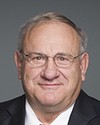When we look at any normal rural area, there are services and buildings. The white square on this slide has the points of presence, and those are owned by private providers today. Let's say the outside ones are Bell Canada and some of the spurs are some smaller providers. All those services are privately held. We go to RFP. We've identified where all those yellow pieces are by doing a pre-qualification with the providers and requiring them to tell us where their fibre is.
We are going to go to public RFP and say these areas in the black spaces need fibre running through them. Not only are you going to run fibre through them, but you're also going to upgrade the telecom infrastructure, the switching stuff, where all the pieces of fibre plug into the existing points of presence, and we'll add some new ones: our little bird logo. The key point is that we have lots of points of interconnection. Some of that fibre could be owned by one company, and some could be owned by another company, but because our funding requires open access, they must be able to use each other's fibre. We can put in one piece of fibre, but all the providers can compete to deliver services across that fibre. That's where we think the competition comes from, and that's really how the private market works. When there's enough competition, it takes care of service and pricing naturally.
If you look at the left side, it's those orange areas where there's now a business case to connect a tower, a subdivision, a larger enterprise, like an on-farm operation that requires.... We have Mennonites in northern Grey County who have very sophisticated operations that require plans to be sent back and forth to their operation on a farm. They need high-capacity fibre to do that.
Does that answer your question?



